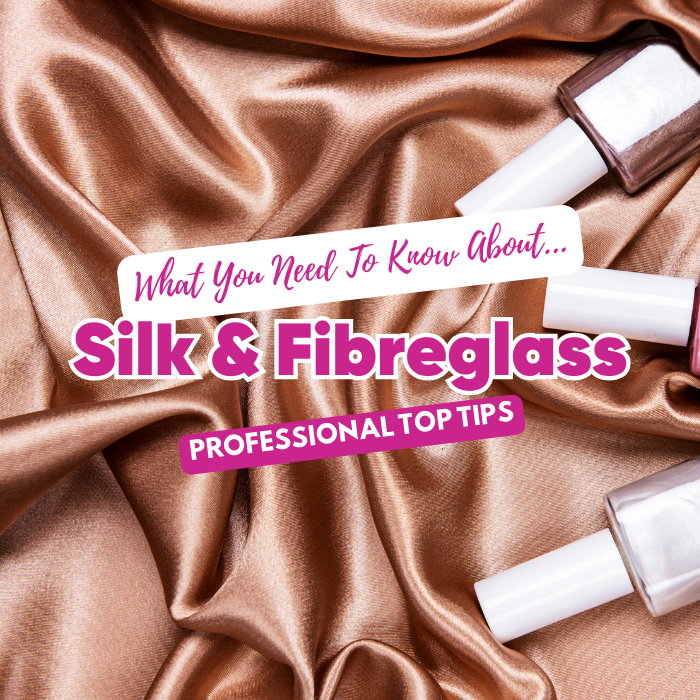
As a working nail technician and educator, many of my clients find Silk and Fibreglass more suitable for their nails and prefer the finished result over UV Gel and Acrylic. In this article I aim to give you an overview of both systems and hopefully allow the new and experienced nail technicians to visit or revisit Silk and Fibreglass, bringing back into the nail industry.
What is Silk and Fibreglass
Silk is a natural fine weave material, often used to strengthen and repair the natural nail.
Fibreglass is a synthetic man-made mesh with a loose weave best suited to strengthen nail extensions. Fibreglass is stronger than Silk
Both Silk and Fibreglass create a strong natural-looking nail which are flexible and easy to remove.
Benefits
- The most flexible of all systems
- Creates a thin, natural-looking nail
- Repairs broken natural nails
- Creates a strong nail extension
- Can be polished over
- Quick application
- Quick removal
Products and equipment
In my professional opinion, Salon Systems products are one of the best on the market. They are affordable but still create a professional set of nails, that are long-lasting and cost-effective.
- Nail antiseptic spray- prepares the nail for application and removes shine and oil
- Resin- Applied over the mesh to secure it in place and make the mesh invisible
- Spray setter- Hardens the resin, and should be sprayed after every layer of resin. Important not to be sprayed too close as can cause an exothermic reaction. Spray at a distance of at least 15 cm away from the natural nail
- Fibreglass/Silk- Mesh applied over the nail leaving a small margin of 1mm around the cuticle to prevent lifting and allow resin to seal the nail
- Stork scissors and tweezers- fine sharp scissors used to cut the mesh and tweezers used to peel the sticky backing off of the mesh
Step-by-step Application
The following is my recommended sequence of steps to take:
- Sanitise and wash hands
- Prepare natural nail – lightly file the surface of the nail to remove the shine
- Push back cuticles
- Spray and wipe nails using nail and file antiseptic spray
- Apply tips if required
- Cut silk/fibreglass to fit the nail, and apply securing onto the nail with the backing. Remembering to leave a 1mm margin around the cuticle
- Cut excess mesh off of the free edge of the nail using the stork scissors
- Apply a thin layer of resin, ensuring all mesh is covered and avoiding touching the surrounding cuticle
- Wait approx 1 minute and spray with a setter at least 15 cm away from the nail
- Apply a second layer of resin
- Spray setter
- Repeat steps 10 and 11
- Lightly file the surface of the nail, to smooth and file the free edge to shape
- Spray and wipe with antiseptic spray
- Apply a UV top coat to seal and add shine. Cure for 2 minutes under a UV lamp
- Finish with some hand cream and nail oil
Tips for application
To ensure you create a set of professional nails that your client is expecting, here are some helpful hints and tips
- Keep all lids on products
- Wipe the resin bottle top before and after use to prevent blockage
- Store mesh in a sealed bag or box away from the rest of the products
- Avoid touching the mesh when applying it to the nail as this can place oils and dirt onto the fabric which can lead to lifting
- Always leave a 1mm margin around the cuticle edge to prevent lifting
- Do not spray the setter too close as can cause an exothermic reaction
- Only cut the mesh with the stork scissors to prevent fraying of the mesh
- Apply enough resin to cover the mesh
Aftercare
Aftercare is essential for all nail systems, however often something that is forgotten by many nail technicians. If the aftercare is not given this can result in the nails not lasting the full 2 weeks for infills.
- Cuticle oil should be applied daily
- Wear protective gloves when cleaning, washing up or gardening
- Do not use the nails as tools treat them as jewels
- Always apply a base coat before polishing to prevent staining
- Remove polish with a non-acetone remover
- Avoid filing the nails, leave them to a professional
- Push back cuticles once a week
- Rebook for infills every 2 weeks
Silk and Fibreglass should be a system that all nail technicians should offer alongside UV Gel and Acrylic. This enables the technician to provide a range of nails that can meet the needs of every client.
Remember to become a professional nail technician is about keeping all skills up to date and attending refresher courses to maintain continual professional development.
I hope that many of you will try the Silk and Fibreglass system using the step-by-step guide above, and good luck!

Questions:
- How Do I Get More Clients For My Nail Business?
- How Much Should I Charge Clients For My Nail & Beauty Services? A Practical Guide for UK Entrepreneurs
- Am I Using The Right Makeup For My Skin Undertone?
- How Do I Attract Customers to a Nail Salon?
- Do I Need a Business Degree to Start a Nail & Beauty Business?
- Are Acrylic Nail Fumes Dangerous?
- How Do I Market Myself As a Nail Technician?
- What Are The Most Essential Marketing Tools For A Nail & Beauty Business?
- What Is Your Favourite Marketing Tool For Nail & Beauty Salons?
